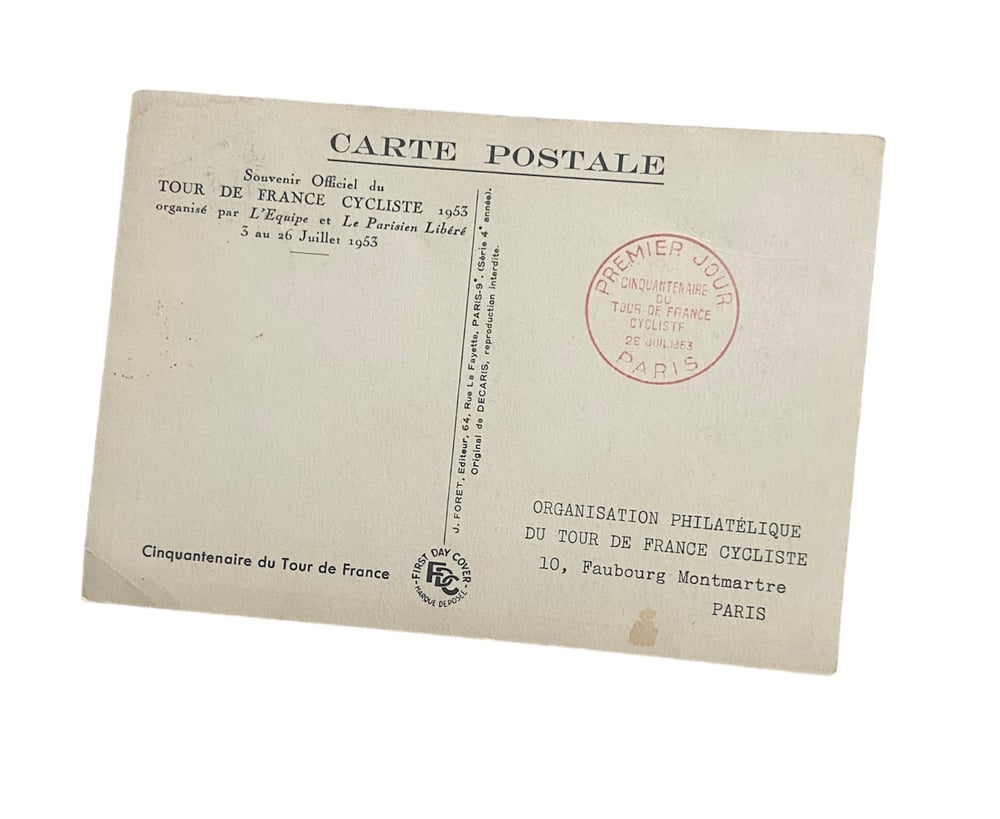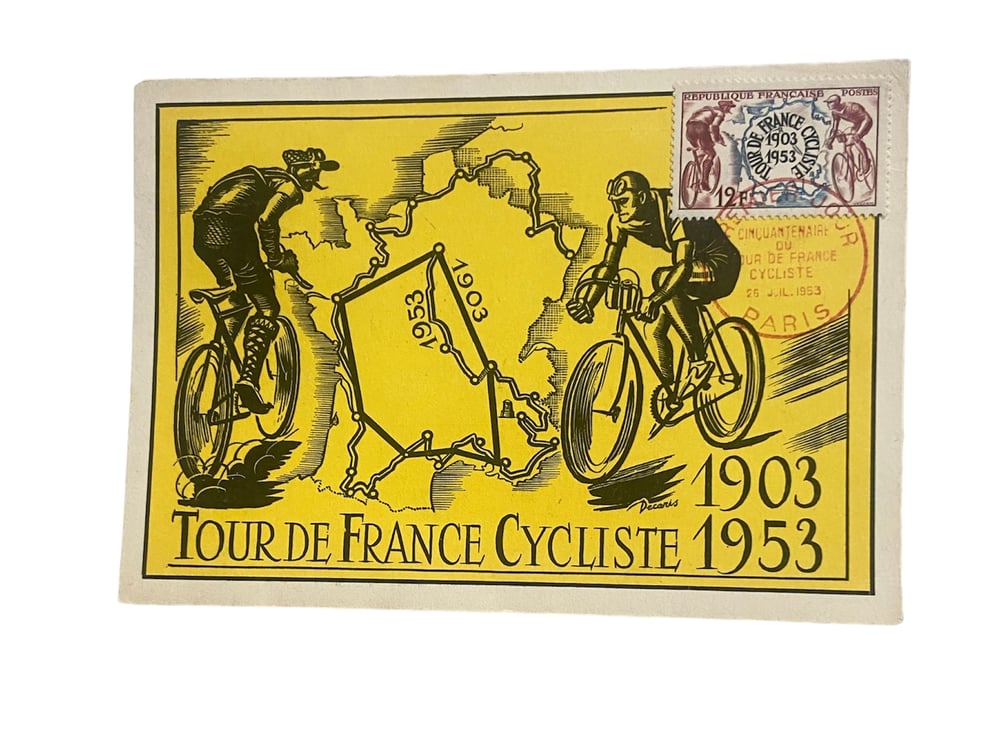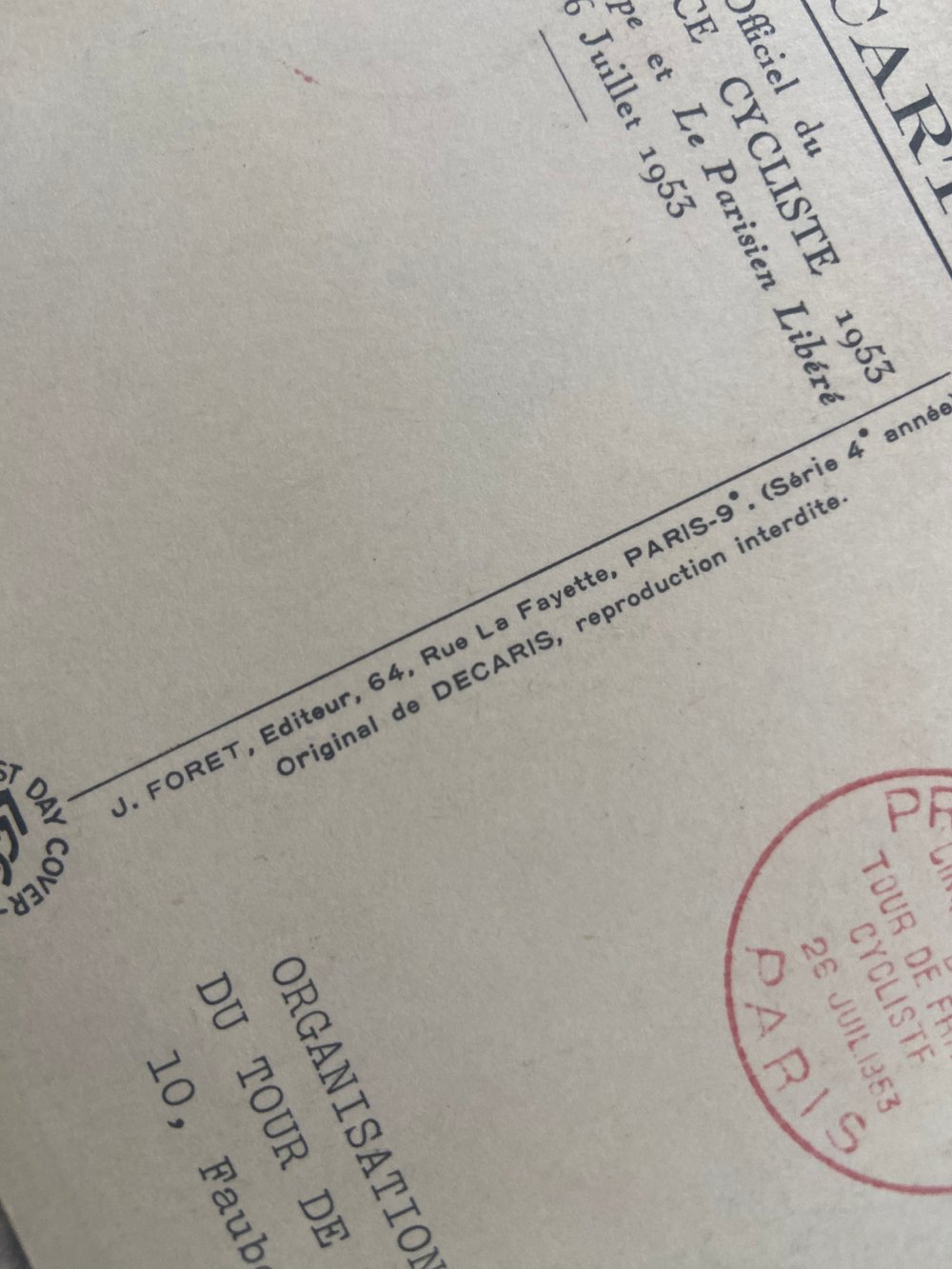The Tour de France by Joseph Foret





Description:
Joseph Forêt, the oversized publisher from Auvergne, had a passion for philately and the history of the Grande Boucle, which he indulged through commemorative cancellations and special envelopes.
HE SOLD POSTCARDS OUT OF HIS LITTLE SUITCASE...
Between 1948 and 1959, Joseph Forêt, this art publisher, sold postcards signed by the greatest artists himself on the Tour, not without some difficulty. Then, in 1960 and 1961, while he was on the Round the World Tour, he had them sold by others.
Orphan, self-taught, bronze-maker,
fabulous art publisher, and above all
a former member of the Vélo-Club de Levallois, the modest, shy, passionate and enterprising Joseph Foret (1901-1991) is perhaps the most extraordinary person to have ever been in the Tour caravan. He may not have been there for more than eleven years, between 1948 and 1959, but he added a real artistic dimension to the race's heritage. And he did so through philately and cartophily. Indeed, this friend of artists took it upon himself to endow the Tour de France and its riders, whom he loved with a true passion, with perfectly unique philatelic-artistic souvenirs signed by the masters Van Dongen (1955), Jean-Gabriel Domergue and Utrillo (1956), Delanglade and Buffet (1958), Dali (1959), Foujita (1960) and Trémois (1961).
An insane challenge, because these works of art celebrating the Tour de France had to be, as he wished, inexpensive. So he printed 500 copies of each card and envelope, franked them and had them specially cancelled at each stage! Today, the whole collection is a marvellous collection of 230 postcards and cancels, as other, less glamorous artists also took part in the adventure, including Maurice Tranchant (1948, 1950), Hertenberger (1949), Cello (1953, 1954), Charles Blanc (1957) and
L.G. Keller (1959).
A DAILY GRIND
The difficulty in all this was that the reckless Joseph Foret didn't have a single vehicle of his own between 1948 and 1954, which forced him to perform impossible acrobatics to follow the race and to post and send his souvenirs at each stage. The shy man therefore forced himself to borrow almost every vehicle in the publicity caravan, from the Ruche de Provence (Montélimar nougat) truck, already overflowing with its ten salesmen, to the Catox van, the Timor truck ("where Timor goes, the insect goes"), not forgetting the Aspro, Kub, Nestlé, Ricard or Waterman racing cars and coaches.
And so as not to get in the way, with his suitcase full of spare belongings and his satchel full of cards and envelopes, the already tiny Joseph made himself even smaller... Moving from one to the other, he didn't go to bed until 10pm, after getting up at 4am. He watched the arrival, went to frank his cards, sold some on a corner of the table, tried in vain to find a room, before ending up in a barracks, a school, a seminary or an old... brothel. When it wasn't on the beach.
During this golden age of the publicity caravan, the leading light was jean Nohain, who regularly hosted Joseph in his bus called "C'est la vie" the title of the programme he was hosting at the time on RTL with Alex Virot, Marie Bizet, Claude Dauphin and jean-Jacques Vital. Then came Reines d'un jour, but Jean Nohain's hospitality never wavered.
And so it was with a touch of nostalgia that Joseph arrived at the 1955 Tour with a Simca Aronde. He then moved on to a Week-End cabriolet, followed by a Ford Thunberbird. It was easier, all the equipment was in the boot, and Misses Reboh or Delorme helped Joseph sell his mer-veilles, when his charming wife Renée wasn't there herself to lend a hand. As the years went by, this goodwill poker game meant that Joseph now took on board the wives of friends, such as that of Doctor Dumas.
But having come full circle, even if he remained attached to "his" beloved Tour, the little adventurer from Le Mont-Dore was dreaming of something else. He had just created L'Apocalypse, the book of books. A fantastic work, with a cover by Salvador Dali.
With this masterpiece, and because of it, he would not be following the 1960 and 1961 Tours, but would be marvelling at the Tour around the world until 1974. A global epic, whose origin was undoubtedly the Tour's caravan, and the adventures he experienced in it.
Un éditeur hors du commun!
Joseph Forêt, l’éditeur auvergnat démesuré, nourrissait une passion pour la philatélie et l’histoire de la Grande Boucle, qu’il assouvit au travers d’oblitérations commémoratives et d’enveloppes spéciales.
IL VENDAIT DES CARTES POSTALES AVEC SA PETITE VALISE…
Entre 1948 et 1959, Joseph Forêt, cet éditeur d'art vendit lui-même sur le Tour des cartes postales signées des plus grands artistes, non sans mal d'ailleurs. Puis, en 1960 et 1961, passant quant à lui au Tour du monde, il les fit vendre par d'autres.
Orphelin, autodidacte, bronzier,
fabuleux éditeur d'art, et surtout
ancien bon sociétaire du Vélo-Club de Levallois, le modeste, timide, passionné et entreprenant Joseph Foret (1901-1991) est peut-être le personnage le plus extraordinaire qui ait jamais fréquenté la caravane du Tour. Certes, son passage n'excéda pas les onze ans, entre 1948 et 1959, mais il apporta au patrimoine de la course une vraie dimension artistique. Et ce par le biais de la philatélie et de la cartophilie. En effet, cet ami des artistes se mit en tête de doter le Tour de France et ses coureurs, qu'il aimait de passion vraie, de souvenirs philatélico-artistiques parfaitement uniques puisque signés par les maîtres Van Dongen (1955), Jean-Gabriel Domergue et
Utrillo (1956), Delanglade et Buffet (1958), Dali (1959), Foujita (1960) et Trémois (1961).
Un challenge insensé, car ces œuvres d'art célébrant le Tour de France devaient être, c'était son souhait, bon marché. Moyennant quoi, il tirait à 500 exemplaires chacune des cartes et enveloppes, qu'il affranchissait et faisait spécialement oblitérer à chaque étape! Le tout représente aujourd'hui un merveilleux ensemble de 230 cartes postales et cachets, car participèrent aussi à l'aventure d'autres artistes un peu moins huppés, comme Maurice Tranchant (1948, 1950), Hertenberger (1949), Cello (1953, 1954), Charles Blanc (1957), ou
L.G. Keller (1959).
UNE DÉBROUILLE DE TOUS LES JOURS
La difficulté dans tout cela, c'est que le téméraire Joseph Foret n'eut pas le moindre véhicule à lui entre 1948 et 1954, ce qui l'obligea à des acrobaties impossibles pour suivre la course, affranchir et expédier ses souvenirs à chaque étape. Le timide força donc sa nature pour emprunter quasiment tous les véhicules de la caravane publici-taire, du camion de La Ruche de Provence (nougat de Montélimar) débordant déjà de ses dix vendeurs, à la camionnette Catox, au camion Timor (« où Timor passe, l'insecte trépasse »), en passant par les bolides et cars Aspro, Kub, Nestlé, Ricard ou Waterman.
Et pour ne pas gêner, avec sa valise d'effets de rechange et sa sacoche pleine de cartes et enveloppes, le déjà minuscule Joseph se faisait encore plus petit... Passant de l'un à l'autre, il ne se couchait pas avant 22h, après s'être levé à 4h du matin. Il avait regardé l'arrivée, était allé affranchir ses cartes, en avait vendu quelques-unes sur un coin de table, avait essayé en vain de trouver une chambre, avant de se retrouver, dans une caserne, une école, un séminaire ou une ancienne... maison close. Quand ce n'était pas sur la plage.
Durant cet âge d'or de la caravane publici-taire, l'homme phare en était jean Nohain, qui hébergeait régulièrement Joseph dans son car nommé C'est la vie, titre de l'émission qu'il animait alors sur RTL avec Alex Virot, Marie Bizet, Claude Dauphin et jean-Jacques Vital. Ensuite, ce fut Reines d'un jour, mais l'hospitalité de jean Nohain ne se démentit jamais.
Et c'est donc avec une petite pointe de nostalgie que Joseph débarqua sur le Tour 1955 avec une Simca Aronde. Ensuite, il passa à un cabriolet Week-End, puis à une Ford Thunberbird. C'était plus facile, tout le matériel était dans le coffre, et Mlles Reboh ou Delorme aidaient Joseph à vendre ses mer-veilles, quand sa charmante épouse Renée ne venait pas elle-même donner un coup de main. Car, au fil des ans, ce coup de poker bons procédés, Joseph prenait maintenant à son bord les épouses des copains, par exemple celle du docteur Dumas.
Mais ayant fait le tour de la question, même s'il restait attaché à « son » cher Tour, le petit aventurier du Mont-Dore rêvait d'autre chose. Il venait de créer L'Apocalypse, le livre des livres. Une pièce fantastique, dont la couverture était signée Salvador Dali.
Avec ce chef-d'œuvre et à cause de lui, il ne suivrait pas les Tours 1960 et 1961, mais émerveillerait le Tour du monde entier jusqu'en 1974. Une épopée planétaire, dont : l'origine fut assurément la caravane du Tour, et les aventures qu'il y vécut.
